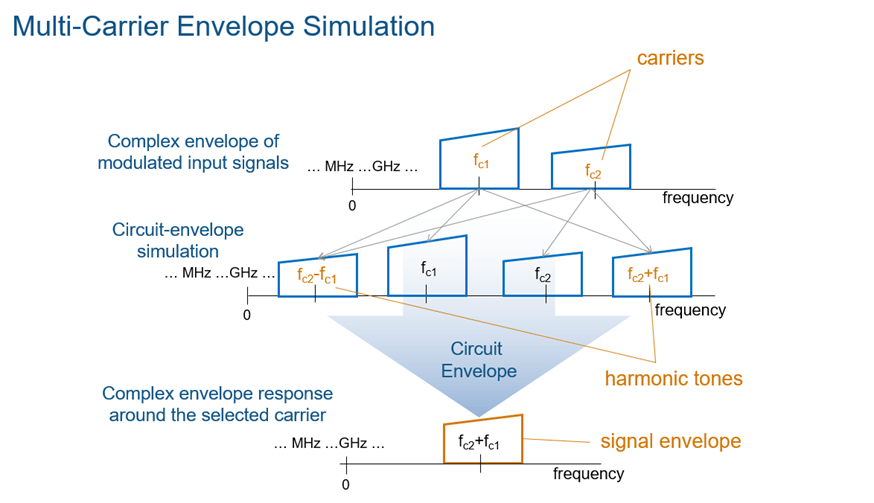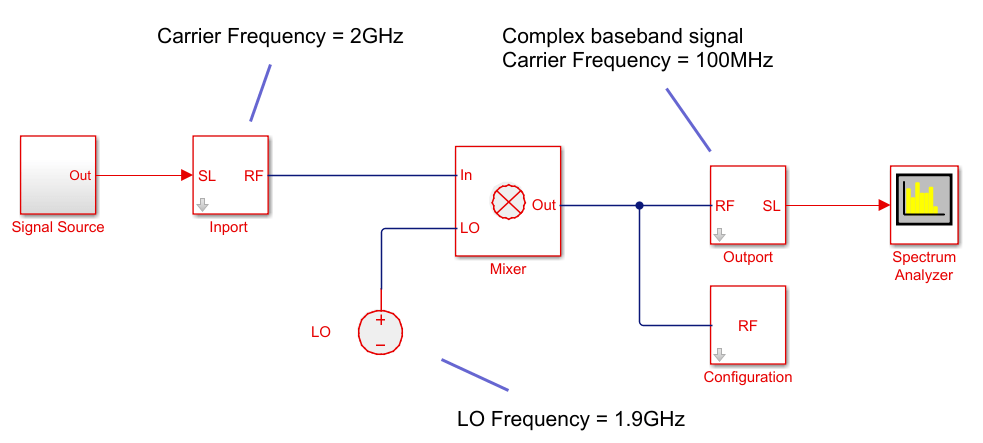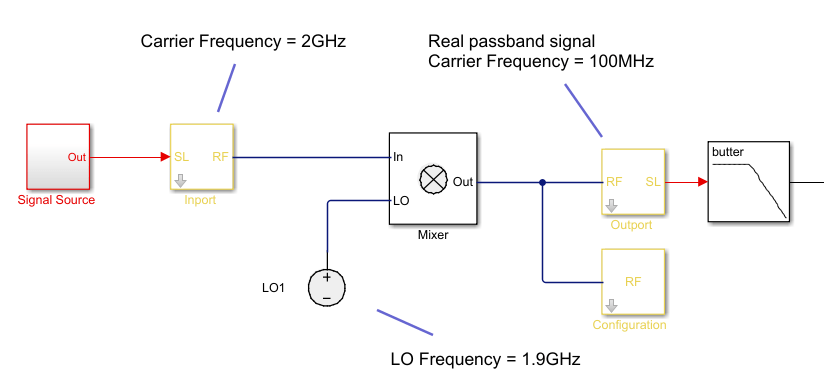Outport
Convert RF Blockset signal to Simulink output signals
Libraries:
RF Blockset /
Circuit Envelope /
Utilities
Description
The Outport block outputs carrier modulation signals in the RF Blockset™ circuit envelope simulation environment as Simulink® signal. For an introduction to RF simulation, see the example, Simulate High Frequency Components.
The output port senses current and voltage complex envelope or real passband signals. Complex baseband signals consist of in-phase (Ik) and quadrature (Qk) components centered around each specified center frequency fk. The Sensor type parameter determines which signal the block measures, and the Output parameter defines the format of the Simulink signal. For more information, see How to Use Outport Block.
Outport block icons are dynamic and show the current format of the output signal. For more information, see Outport Block Icons.
Note
Outport block Real passband output does
not support frame-based processing (supported by the Configuration blocks). This block errors if the Samples per
frame is more than 1 in the Configuration block.
Examples
Passband Signal Representation in Circuit Envelope
Learn how to represent passband signal in circuit envelope environment.
Validating IP2/IP3 Using Complex Signals
Run a two-tone experiment to measure the second- and third-order intercept points of an amplifier.
Parameters
Type of signal measured by sensor, specified as:
Ideal voltage— The block outputs the modulations of the voltage signal at the specified Carrier frequencies in the format specified by the Output parameter. This is the recommended option to sense a signal without adding a loading impedance and changing matching conditions.Ideal current— The block outputs the modulations of the current signal at the specified Carrier frequencies in the format specified by the Output parameter.Power— The block outputs the modulations of the voltage signal at the specified Carrier frequencies and scaled with respect to the specified load impedance. This is the recommended option to sense a signal generated in RF Blockset 50 Ohm environment or a different reference impedance. When you use the power option , the output port automatically inserts a load impedance in your circuit.where Zl is the value of the Load impedance (Ohm) parameter.
Load impedance of RF circuit used to measure signal power, specified as a vector of positive integers in ohms. When you use the power option , the output port automatically inserts a load impedance in your circuit. When you use multiple Outport blocks as power sources at the same node in a given circuit, the resulting load is the parallel combination of the specified load impedances.
Dependencies
To enable this parameter, select Power in Sensor
type.
Format of output signals, specified as one of the following:
Complex Baseband— The block outputs a vector of complex-valued signals Ik(t) + j · Qk(t) at the port labeled SL. The kth element of the vector is the kth frequency specified by the Carrier frequencies parameter.In-phase and Quadrature Baseband— The block outputs two vectors of real-valued signals Ik(t) and Qk(t) at the I port and Q port, respectively. The signal at the I port contains the in-phase components, and the signal at the Q port contains the quadrature components. The kth element of the vector is the kth frequency specified by the Carrier frequencies parameter. The quadrature component of a signal with carrier frequency equal to 0 Hz is zero.Magnitude and Angle Baseband— The block outputs two real-valued vectors, whose elements are the magnitude and phase angle of the modulation. The Mag port outputs |Ik(t) + j · Qk(t)| and the Ang port outputs Arg[Ik(t) + j · Qk(t)]. The kth element of the vector is the kth frequency specified by the Carrier frequencies parameter.Real Passband— The block outputs real passband signals by combining envelope and carrier signals for all frequencies listed under Carrier frequencies. When using theReal Passbandoption, the solver takes time steps small enough to resolve the carrier. Thus, simulation speed improvements from envelope simulation may be limited.where
tis the value of Load impedance (Ohm) parameter.
Determine optimal time step to resolve highest listed carrier frequency, specified as a
on or off. Select this parameter
to allow RF Blockset to determine the optimal time step to resolve the highest
listed carrier frequency. Clear the parameter selection to enter a value for
step size.
Time step, specified as a positive integer in seconds. The step size should be small enough to resolve the fastest carrier signal. The size helps to avoid passband output undersampling and aliasing effects.
Set the time step value to -1 to inherit
the time step specified from Step size in Configuration block.
Since R2023a
Half-polyphase length of filter, specified as a nonegative integer. Set
the half-polyphase length to a value greater than zero to mitigate undesired
spectral images on a real passband output. If you set this parameter to
0, then the block does not filter.
Dependencies
To enable this parameter, set Output to
Real Passband.
Carrier frequencies, specified as a vector of positive integers in Hz. In carrier frequencies, the elements are a combination of fundamental tones and corresponding harmonics in the Configuration block.
Ground RF circuit terminals, specified as a on or off.
Select this parameter to ground and hide the negative terminals. Clear the
parameter to expose the negative terminals. By exposing these terminals, you
can connect them to other parts of your model.
By default, this option is selected.
More About
Using the Inport block you can specify the complex envelopes of your input signals and import them as RF signals for multi-carrier simulation.
The Configuration block automatically determines the fundamental tones specified in the input ports and proposes a suitable harmonic order to capture the non-linearity of the system. You can also manually specify the harmonic order for each fundamental tone in the simulation.
In the input port, you can specify as many carrier frequencies as you want. It is recommended that you trade off the simulation bandwidth (inversely proportional to the simulation time step) and the total number of simulation frequencies.

Normalized carrier power option in the Configuration block defines the passband formula:
When this option is selected, RF Blockset interprets complex envelope I+jQ signal for the kth carrier as,
When this option is not selected, the signal on the kth
In both cases, the signal for zero-frequency (DC) carrier is x( t ) = I( t ). The final output signal is computed as s(t) = sum( sk )
The formula for the time step selected is:
f is the largest listed carrier frequency.
h is the time step listed in Configuration block.
Outport block icons are dynamic and show the current format of the output signal. This table shows how the block icons vary based on how you set the Sensor type, Ground and hide negative terminals, and Output parameters.
| Sensor type | Ground and hide negative terminal | Output: Complex Baseband | Output: In-phase and Quadrature
Baseband | Output: Magnitude and Angle Baseband | Output: Real Passband |
|---|---|---|---|---|---|
Ideal voltage | On |
|
|
|
|
Off |
|
|
|
| |
Ideal current | On |
|
|
|
|
Off |
|
|
|
| |
Power | On |
|
|
|
|
Off |
|
|
|
|
Algorithms
Consider an RF chain composed by several stages. You want to sense and inspect the signal behavior at different intermediate nodes.
Use the power input port and power sensor port at the input and output of your chain, as gateways between Simulink (reference 1 ohm) and the RF domain.
Use the voltage or current output ports connected to the intermediate nodes and branches that you want to inspect. To measure the power of a voltage signal, change the default spectrum analyzer reference impedance to 50 ohm.

Output signal is a combination of (digital communication) complex equivalent
baseband signals (I,Q). For each envelope, assume an implicit center frequency
for the signal that is equal to the carrier
frequency,Fc.
Enter the array
Fcin the Carrier Frequencies parameter corresponding to the center frequency of the envelopes that you want to sense. The output signals is an array of complex (I,Q) envelopes.The output port of sensor type power provides a termination (by default 50Ohm) at the end of the chain.
The simulation step size in the Configuration block is the same as the sample time of the Simulink signal, and it is not related to the carrier frequency.

Output signal is a (digital communication) complex baseband signal (I,Q) resulted from a direct conversion receiver. Assume that no carrier is associated with the output signal.
Use two Outport blocks for the I and Q components of the signal. Set the Carrier Frequencies parameter of each Outport block to
0. Use the real passband option to sense a real signal rather than a complex signal with quadrature component equal to0.The output ports of sensor type power provide a termination (by default 50Ohm) at the end of the chain.
To down-convert the signal, use an IQ Demodulator block. Set the Local oscillator frequency to
Fcequal to the center frequency of the input signal (direct conversion).The simulation step size in the configuration block is the same as the sample time of the Simulink signal, and it is not related to the Local Oscillator frequency.

Output signal is a (digital communication) complex equivalent baseband signal (I,Q) down-converted to intermediate frequency (IF). Apply digital signal processing techniques for processing the complex equivalent baseband information of the signal.
Set the Carrier frequencies parameter of the Outport block to
IF. Use the complex baseband option.Use the Mixer block for down-conversion. Set the LO carrier frequency to
LO = RF-IF. The output port will behave as an ideal filter and select only the down-converted signal. The envelope atRF+LO = 2RF-IFfrequency is simulated but it is not sensed by the output port.The simulation step size in the configuration block is the same as the sample time of the Simulink input signal, and it is not related to the IF, RF or LO frequencies.

Output signal is a (digital communication) signal (I,Q) down-converted to intermediate frequency (IF). Apply analog signal processing techniques to the output signal.
Set the Carrier frequencies parameter of the Output block to
IF. Use the real passband option.If the intermediate frequency is within the simulation bandwidth defined in the configuration block, Use the same step size in the output without the need for resampling the signal.
If the intermediate frequency is not within the simulation bandwidth defined in the configuration block, you need to resample the signal (as described in the real-passband formula) to correctly resample the carrier.
Use the Mixer block. Set the LO carrier frequency to
LO = RF-IF. The output port will behave as an ideal filter, and select only the down-converted signal. The envelope atRF+LO = 2RF-IFfrequency is simulated but it is not sensed by the output port.The simulation step size in the configuration block is the same as the sample time of the Simulink input signal. All the blocks in the RF Blockset network connected to the configuration block are executed with the same step size. The time step of the outport, when the real passband option is selected, might differ from the time step of the input Simulink signal and of the time step set in the configuration block.

Version History
Introduced in R2010bThe Outport block now supports an FIR interpolation filter for real passband output to mitigate undesired spectral images.
The Outport block icon now changes based on how you set the Sensor type, Ground and hide negative terminals, and Output parameters. When you open a model created before R2022b containing an Outport block, the software replaces the block icon with the R2022b version.
The Outport block icon was updated in R2021b. When you open a model created before R2021b containing an Outport block, the software replaces the block icon with the R2021b version.
See Also
MATLAB Command
You clicked a link that corresponds to this MATLAB command:
Run the command by entering it in the MATLAB Command Window. Web browsers do not support MATLAB commands.
Select a Web Site
Choose a web site to get translated content where available and see local events and offers. Based on your location, we recommend that you select: .
You can also select a web site from the following list
How to Get Best Site Performance
Select the China site (in Chinese or English) for best site performance. Other MathWorks country sites are not optimized for visits from your location.
Americas
- América Latina (Español)
- Canada (English)
- United States (English)
Europe
- Belgium (English)
- Denmark (English)
- Deutschland (Deutsch)
- España (Español)
- Finland (English)
- France (Français)
- Ireland (English)
- Italia (Italiano)
- Luxembourg (English)
- Netherlands (English)
- Norway (English)
- Österreich (Deutsch)
- Portugal (English)
- Sweden (English)
- Switzerland
- United Kingdom (English)
























